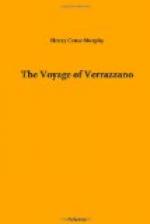The description of the voyage is followed by what the writer calls a cosmography, in which is shown the distance they had sailed from the time they left the desert rocks at Madeira, and the probable size of the new world as compared with the old, with the relative area of land and water on the whole globe. There is nothing striking or important in this supplement, except that it emphasizes and enforces the statements of the former part of the letter in regard to the landfall, fixes the exact point of their departure from the coast for home again at 50 Degrees N. latitude, and gives seven hundred leagues as the extent of the discovery. The length of a longitudinal degree along the parallel of thirty-four, in which it is reiterated they first made land, and between which and the parallel of thirty-two they had sailed from the Desertas, is calculated and found to be fifty-two miles, and the whole number of degrees which they had traversed across the ocean between those parallels, being twelve hundred leagues, or forty-eight hundred miles, is by simple division made ninety-two. The object of this calculation is not apparent, and strikes the reader as if it were a feeble imitation of the manner in which Amerigo Vespucci illustrates his letters. A statement is made, that they took the aim’s altitude from day to day, and noted the observations, together with the rise and fall of the tide, in a little boat, which was “communicated to his majesty, in the hope of promoting science.” It is also mentioned that they had no lunar eclipses, by means of which they could have ascertained the longitude during the voyage. This fact is shown by the tables of Regiomontanus, which had been published long before the alleged voyage, and were open to the world. The statement of it here, therefore, does not, as has been supposed, furnish any evidence in support of the narrative, by redeem of its originality. Such is the account, in brief; which the letter gives of the origin, nature and extent of the alleged discovery; and as it assumes to be the production of the navigator himself, and is the only source of information on the subject, it suggests all the questions which arise in this inquiry. These relate both to the genuineness of the letter, and the truth of its statements; and accordingly bring under consideration the circumstances under which that instrument was made known and has received credit; the alleged promotion of the voyage by the king of France; and the results claimed to have been accomplished thereby. It will be made to appear upon this examination, that the letter, according to the evidence upon which its existence is predicated, could not have been written by Verrazzano; that the instrumentality of the King of France, in any such expedition of discovery as therein described, is unsupported by the history of that country, and is inconsistent with the acknowledged acts of Francis and his successors, and therefore incredible; and that its description




